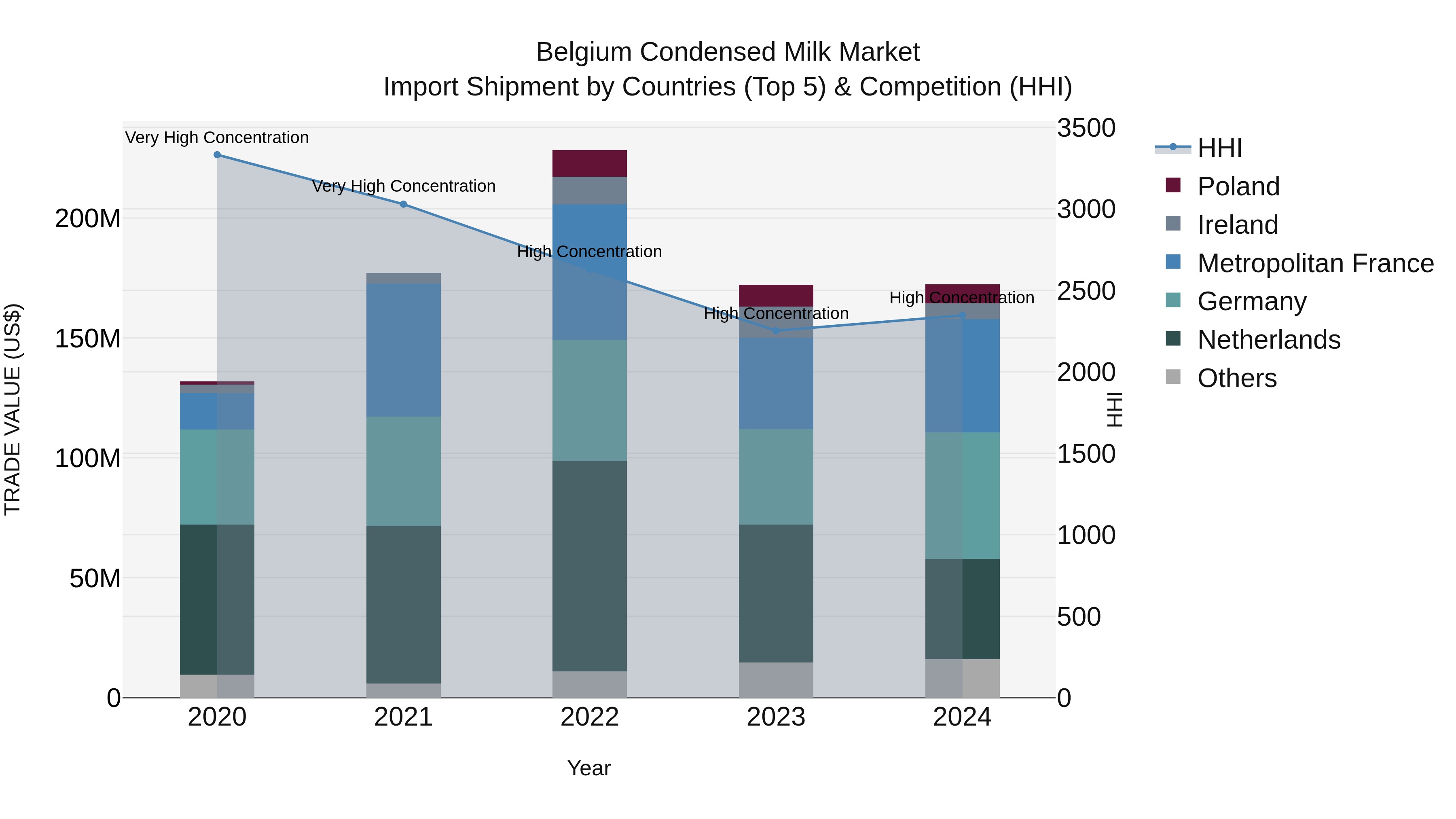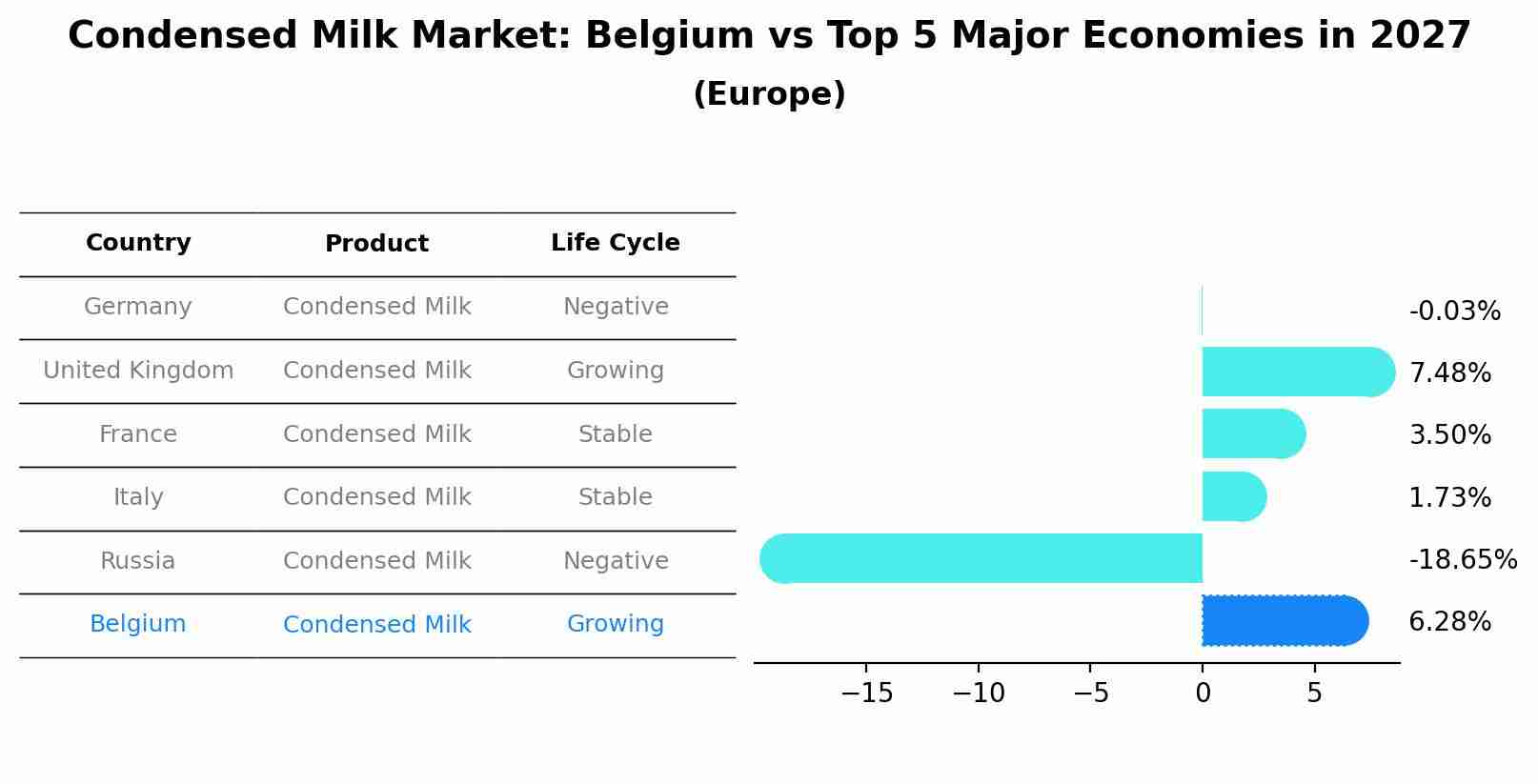Belgium Condensed Milk Market (2025-2031) | Size, Value, Trends, Revenue, Segmentation, Industry, Analysis, Companies, Forecast, Growth, Outlook & Share
| Product Code: ETC4984577 | Publication Date: Nov 2023 | Updated Date: Oct 2025 | Product Type: Market Research Report | |
| Publisher: 6Wresearch | Author: Sachin Kumar Rai | No. of Pages: 60 | No. of Figures: 30 | No. of Tables: 5 |
Belgium Condensed Milk Market Top 5 Importing Countries and Market Competition (HHI) Analysis
In 2024, Belgium continued to see a steady increase in condensed milk import shipments, with key exporting countries being Germany, Metropolitan France, Netherlands, Poland, and Sweden. The high Herfindahl-Hirschman Index (HHI) indicates a concentrated market, suggesting potential for market dominance among key players. With a compound annual growth rate (CAGR) of 6.93% from 2020 to 2024, the market is showing promising growth trends. Although the growth rate slightly slowed to 0.14% in 2024 compared to the previous year, the overall outlook for condensed milk imports in Belgium remains positive.

Condensed Milk Market: Belgium vs Top 5 Major Economies in 2027 (Europe)
By 2027, the Condensed Milk market in Belgium is anticipated to reach a growth rate of 6.28%, as part of an increasingly competitive Europe region, where Germany remains at the forefront, supported by United Kingdom, France, Italy and Russia, driving innovations and market adoption across sectors.

Belgium Condensed Milk Market Overview
The Belgium condensed milk market is characterized by a stable demand driven by its wide application in the food and beverage industry. Condensed milk is popular for its use in baking, confectionery, and dairy-based products. The market is influenced by changing consumer preferences for convenience foods and ready-to-use ingredients. Growth is also supported by the increasing popularity of sweetened condensed milk in various culinary applications and desserts. Key factors such as the expansion of the retail sector and the introduction of new product variants are shaping the market dynamics. Additionally, health-conscious consumers are driving demand for reduced-sugar and alternative formulations of condensed milk.
Drivers of the market
The Belgium condensed milk market is experiencing growth due to a rising preference for convenience foods and the growing use of condensed milk in various culinary applications. The increasing popularity of baked goods, confectioneries, and beverages that incorporate condensed milk is a significant driver. Additionally, the expansion of retail channels and the introduction of new product variations, including low-fat and organic options, are fueling market demand. Consumer trends toward indulgent and premium products also support the growth of the condensed milk market in Belgium.
Challenges of the market
The Belgium Condensed Milk Market is challenged by several factors, including fluctuating milk prices and changing consumer preferences. The volatility in the price of raw milk affects the cost of production for condensed milk, leading to instability in pricing and profitability. Additionally, consumer trends are shifting towards healthier and natural alternatives, which impacts demand for condensed milk. The market also faces regulatory challenges related to food safety and labeling, which can increase compliance costs for manufacturers. Furthermore, competition from both local and international brands adds pressure on prices and market share.
Government Policy of the market
The Belgian condensed milk market is regulated by food safety and quality standards set by the government. Policies focusing on food safety, labeling requirements, and hygiene standards ensure that condensed milk products meet health and safety criteria. Additionally, the governments support for the dairy industry, including subsidies and trade policies, affects the availability and pricing of condensed milk. Efforts to promote local dairy production and sustainability in the dairy sector also impact the market dynamics for condensed milk.
Key Highlights of the Report:
- Belgium Condensed Milk Market Outlook
- Market Size of Belgium Condensed Milk Market, 2024
- Forecast of Belgium Condensed Milk Market, 2031
- Historical Data and Forecast of Belgium Condensed Milk Revenues & Volume for the Period 2021-2031
- Belgium Condensed Milk Market Trend Evolution
- Belgium Condensed Milk Market Drivers and Challenges
- Belgium Condensed Milk Price Trends
- Belgium Condensed Milk Porter`s Five Forces
- Belgium Condensed Milk Industry Life Cycle
- Historical Data and Forecast of Belgium Condensed Milk Market Revenues & Volume By Product Type for the Period 2021-2031
- Historical Data and Forecast of Belgium Condensed Milk Market Revenues & Volume By Dairy for the Period 2021-2031
- Historical Data and Forecast of Belgium Condensed Milk Market Revenues & Volume By Non-Dairy for the Period 2021-2031
- Historical Data and Forecast of Belgium Condensed Milk Market Revenues & Volume By Packaging Type for the Period 2021-2031
- Historical Data and Forecast of Belgium Condensed Milk Market Revenues & Volume By Cans for the Period 2021-2031
- Historical Data and Forecast of Belgium Condensed Milk Market Revenues & Volume By Tubes for the Period 2021-2031
- Historical Data and Forecast of Belgium Condensed Milk Market Revenues & Volume By Bottles for the Period 2021-2031
- Historical Data and Forecast of Belgium Condensed Milk Market Revenues & Volume By Distribution Channel for the Period 2021-2031
- Historical Data and Forecast of Belgium Condensed Milk Market Revenues & Volume By Supermarkets and Hypermarkets for the Period 2021-2031
- Historical Data and Forecast of Belgium Condensed Milk Market Revenues & Volume By Convenience Stores for the Period 2021-2031
- Historical Data and Forecast of Belgium Condensed Milk Market Revenues & Volume By Specialty Stores for the Period 2021-2031
- Historical Data and Forecast of Belgium Condensed Milk Market Revenues & Volume By Online Retails for the Period 2021-2031
- Historical Data and Forecast of Belgium Condensed Milk Market Revenues & Volume By Others for the Period 2021-2031
- Belgium Condensed Milk Import Export Trade Statistics
- Market Opportunity Assessment By Product Type
- Market Opportunity Assessment By Packaging Type
- Market Opportunity Assessment By Distribution Channel
- Belgium Condensed Milk Top Companies Market Share
- Belgium Condensed Milk Competitive Benchmarking By Technical and Operational Parameters
- Belgium Condensed Milk Company Profiles
- Belgium Condensed Milk Key Strategic Recommendations
Frequently Asked Questions About the Market Study (FAQs):
1 Executive Summary |
2 Introduction |
2.1 Key Highlights of the Report |
2.2 Report Description |
2.3 Market Scope & Segmentation |
2.4 Research Methodology |
2.5 Assumptions |
3 Belgium Condensed Milk Market Overview |
3.1 Belgium Country Macro Economic Indicators |
3.2 Belgium Condensed Milk Market Revenues & Volume, 2021 & 2031F |
3.3 Belgium Condensed Milk Market - Industry Life Cycle |
3.4 Belgium Condensed Milk Market - Porter's Five Forces |
3.5 Belgium Condensed Milk Market Revenues & Volume Share, By Product Type, 2021 & 2031F |
3.6 Belgium Condensed Milk Market Revenues & Volume Share, By Packaging Type, 2021 & 2031F |
3.7 Belgium Condensed Milk Market Revenues & Volume Share, By Distribution Channel, 2021 & 2031F |
4 Belgium Condensed Milk Market Dynamics |
4.1 Impact Analysis |
4.2 Market Drivers |
4.2.1 Increasing consumer preference for convenience foods |
4.2.2 Growing health consciousness among consumers |
4.2.3 Rising demand for bakery and confectionery products |
4.3 Market Restraints |
4.3.1 Fluctuating prices of raw materials |
4.3.2 Stringent regulations related to food safety and quality standards |
5 Belgium Condensed Milk Market Trends |
6 Belgium Condensed Milk Market Segmentations |
6.1 Belgium Condensed Milk Market, By Product Type |
6.1.1 Overview and Analysis |
6.1.2 Belgium Condensed Milk Market Revenues & Volume, By Dairy, 2021-2031F |
6.1.3 Belgium Condensed Milk Market Revenues & Volume, By Non-Dairy, 2021-2031F |
6.2 Belgium Condensed Milk Market, By Packaging Type |
6.2.1 Overview and Analysis |
6.2.2 Belgium Condensed Milk Market Revenues & Volume, By Cans, 2021-2031F |
6.2.3 Belgium Condensed Milk Market Revenues & Volume, By Tubes, 2021-2031F |
6.2.4 Belgium Condensed Milk Market Revenues & Volume, By Bottles, 2021-2031F |
6.3 Belgium Condensed Milk Market, By Distribution Channel |
6.3.1 Overview and Analysis |
6.3.2 Belgium Condensed Milk Market Revenues & Volume, By Supermarkets and Hypermarkets, 2021-2031F |
6.3.3 Belgium Condensed Milk Market Revenues & Volume, By Convenience Stores, 2021-2031F |
6.3.4 Belgium Condensed Milk Market Revenues & Volume, By Specialty Stores, 2021-2031F |
6.3.5 Belgium Condensed Milk Market Revenues & Volume, By Online Retails, 2021-2031F |
6.3.6 Belgium Condensed Milk Market Revenues & Volume, By Others, 2021-2031F |
7 Belgium Condensed Milk Market Import-Export Trade Statistics |
7.1 Belgium Condensed Milk Market Export to Major Countries |
7.2 Belgium Condensed Milk Market Imports from Major Countries |
8 Belgium Condensed Milk Market Key Performance Indicators |
8.1 Consumer demand for convenient food options |
8.2 Health trends influencing purchasing decisions |
8.3 Growth in the bakery and confectionery sector in Belgium |
9 Belgium Condensed Milk Market - Opportunity Assessment |
9.1 Belgium Condensed Milk Market Opportunity Assessment, By Product Type, 2021 & 2031F |
9.2 Belgium Condensed Milk Market Opportunity Assessment, By Packaging Type, 2021 & 2031F |
9.3 Belgium Condensed Milk Market Opportunity Assessment, By Distribution Channel, 2021 & 2031F |
10 Belgium Condensed Milk Market - Competitive Landscape |
10.1 Belgium Condensed Milk Market Revenue Share, By Companies, 2024 |
10.2 Belgium Condensed Milk Market Competitive Benchmarking, By Operating and Technical Parameters |
11 Company Profiles |
12 Recommendations | 13 Disclaimer |
- Single User License$ 1,995
- Department License$ 2,400
- Site License$ 3,120
- Global License$ 3,795
Search
Thought Leadership and Analyst Meet
Our Clients
Related Reports
- Afghanistan Apparel Market (2026-2032) | Growth, Outlook, Industry, Segmentation, Forecast, Size, Companies, Trends, Value, Share, Analysis & Revenue
- Canada Oil and Gas Market (2026-2032) | Share, Segmentation, Value, Industry, Trends, Forecast, Analysis, Size & Revenue, Growth, Competitive Landscape, Outlook, Companies
- Germany Breakfast Food Market (2026-2032) | Industry, Share, Growth, Size, Companies, Value, Analysis, Revenue, Trends, Forecast & Outlook
- Australia Briquette Market (2025-2031) | Growth, Size, Revenue, Forecast, Analysis, Trends, Value, Share, Industry & Companies
- Vietnam System Integrator Market (2025-2031) | Size, Companies, Analysis, Industry, Value, Forecast, Growth, Trends, Revenue & Share
- ASEAN and Thailand Brain Health Supplements Market (2025-2031) | Strategy, Consumer Insights, Analysis, Investment Trends, Opportunities, Growth, Size, Share, Industry, Revenue, Segments, Value, Segmentation, Supply, Forecast, Restraints, Outlook, Competition, Drivers, Trends, Demand, Pricing Analysis, Competitive, Strategic Insights, Companies, Challenges
- ASEAN Bearings Market (2025-2031) | Strategy, Consumer Insights, Analysis, Investment Trends, Opportunities, Growth, Size, Share, Industry, Revenue, Segments, Value, Segmentation, Supply, Forecast, Restraints, Outlook, Competition, Drivers, Trends, Demand, Pricing Analysis, Competitive, Strategic Insights, Companies, Challenges
- Europe Flooring Market (2025-2031) | Outlook, Share, Industry, Trends, Forecast, Companies, Revenue, Size, Analysis, Growth & Value
- Saudi Arabia Manlift Market (2025-2031) | Outlook, Size, Growth, Trends, Companies, Industry, Revenue, Value, Share, Forecast & Analysis
- Uganda Excavator, Crane, and Wheel Loaders Market (2025-2031) | Strategy, Consumer Insights, Analysis, Investment Trends, Opportunities, Growth, Size, Share, Industry, Revenue, Segments, Value, Segmentation, Supply, Forecast, Restraints, Outlook, Competition, Drivers, Trends, Demand, Pricing Analysis, Competitive, Strategic Insights, Companies, Challenges
Industry Events and Analyst Meet
Whitepaper
- Middle East & Africa Commercial Security Market Click here to view more.
- Middle East & Africa Fire Safety Systems & Equipment Market Click here to view more.
- GCC Drone Market Click here to view more.
- Middle East Lighting Fixture Market Click here to view more.
- GCC Physical & Perimeter Security Market Click here to view more.
6WResearch In News
- Doha a strategic location for EV manufacturing hub: IPA Qatar
- Demand for luxury TVs surging in the GCC, says Samsung
- Empowering Growth: The Thriving Journey of Bangladesh’s Cable Industry
- Demand for luxury TVs surging in the GCC, says Samsung
- Video call with a traditional healer? Once unthinkable, it’s now common in South Africa
- Intelligent Buildings To Smooth GCC’s Path To Net Zero


















